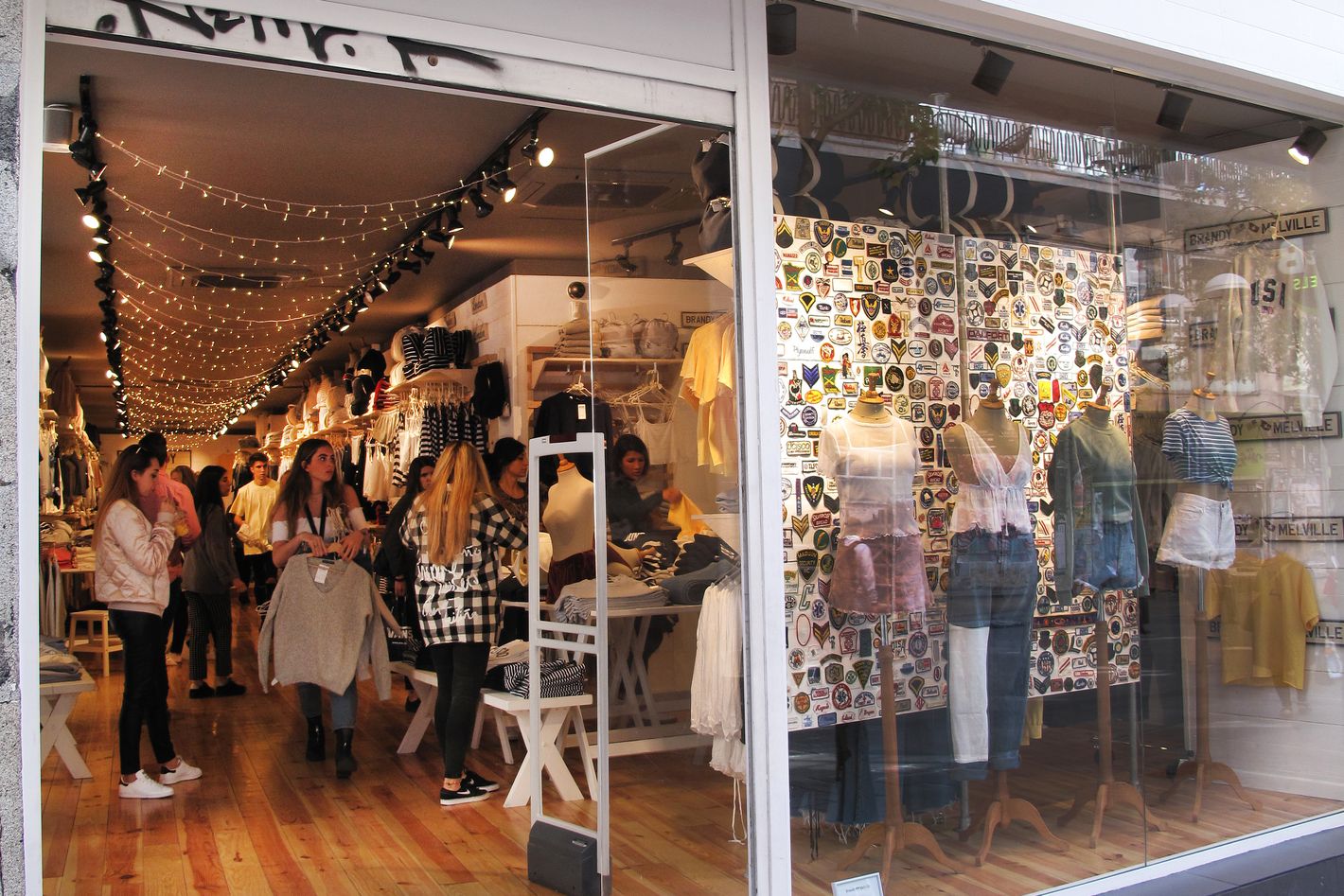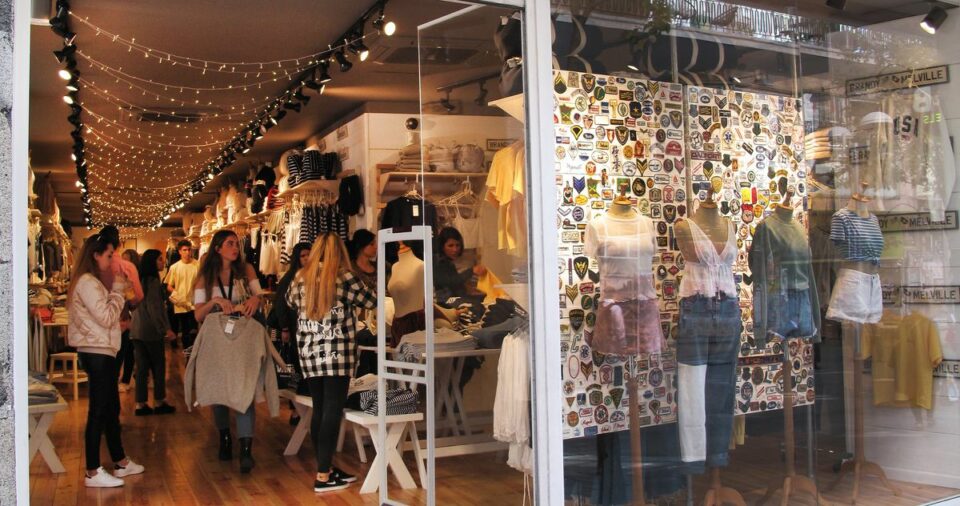
Brandy Hellville & the Cult of Fast Fashion, a new documentary detailing a laundry list of alarming, racist, and possibly illegal practices by Brandy Melville, is showing on HBO. The film, directed by Academy Award winner Eva Orner, centers on the reporting of Business Insider’s Kate Taylor. It features former employees and associates of the fast-fashion retailer, which became a staple among young women and girls in the U.S. in the 2010s. Throughout the documentary, sources highlight allegations of fatphobia, antisemitism, inappropriate conduct with minors, and even sexual assault, most of which lead back to Italian brand founder Stephan Marsan, who continues to serve as the brand’s CEO.
If you’re not familiar with Brandy Melville, consider yourself lucky. For those of us who experienced their one-size-fits-all mentality and obsession with a certain type of girl, it was a place riddled with toxicity. The chain was an odd manufactured oasis that sold a sort of lifestyle to those of us who were young, impressionable, and dealing with the insecurities that often accompany adolescence and young adulthood. I remember it as a Tinseltown of Tumblr paraphernalia, covered with flags and Americana décor and string lights, dotted with beachy wooden signs and staffed with thin, intentionally good-looking, blonde girls. The brand’s bread and butter were, and continue to be, sweaters that look vaguely vintage, baby tees, camisoles, and miniskirts. Many of us, filled with naïveté and hope, wished we could be Brandy girls, too — girls who lived in California and went to the beach after school and stuck their sun-streaked hair out car windows without a care in the world. Too bad a very exclusive sizing system often stood in the way.
Marsan had unspoken policies about who a Brandy girl could be, and he allegedly had illegal practices for keeping it that way. Reportedly, he preferred the white employees out on the floor and the Black and POC employees allocated to the back rooms doing stock. Marsan also allegedly had the employees, who were sometimes underage, send full-body pictures to him every time they had a shift. If he didn’t like the way they looked, he would have them fired, according to the documentary. According to Taylor, former executives and associates of Brandy Melville have filed two lawsuits against Marsan including “serious allegations of racism.” Marsan didn’t respond to the filmmaker’s request for an interview. Below, we detail some of the most seriously messed-up allegations against the brand.
Thin white employees placed at the front of the store, while Black and POC employees worked the stockroom
The filmmakers chronicle alleged habitual racism and body shaming by Marsan through their interviews with former employees and Taylor (and two lawsuits backing up their claims). It was an unspoken rule that the young women and girls hired to work at Brandy Melville were expected to look and dress a certain way, i.e., thin, white, and conventionally attractive. According to the documentary, Black and POC employees often worked in the back while white employees were given roles in the front of the store as the face of the brand. Former employees in the documentary said they were often made to feel insecure of their bodies, many of them noting they had eating disorders while working at Brandy Melville.
One former staffer said she was told she was being let go because upper management from Italy didn’t like her body type. A former vice-president said Marsan would text him and ask him to fire employees if he saw a girl whose look he didn’t like working in a store. Marsan was able to keep tabs on all of his staffers because they were reportedly required to take “staff style” photos, or full-body shots, at the beginning of every shift and send them to Marsan and his right-hand, Jessy, who ran the very popular Brandy Melville Instagram. Many of these girls having their pictures taken were underage and didn’t know where the photos were going. One former employee reported that Marsan had a file of these photos saved, and another said requests began coming in for “chest and feet” pictures. The former vice-president interviewed said management had a group chat for each store where they would receive the pictures from the girls, and if Marsan didn’t like some of them, he’d ask for their termination.
The alleged misconduct didn’t stop at employees. Even customers were asked to have their photo taken if they met Marsan’s standard of looks. He even went as far as to allegedly install buttons at cash registers that would light up, alerting the employees working that he wanted a photo taken of whoever was checking out and a job at Brandy offered to them.

A “one size fits all” sizing system, which has been rebranded into “one size fits most”
Brandy Melville is notorious for not having any sort of sizing on its clothing, which remains true even today. Its slogan used to be “one size fits all” until, after customer backlash, it was forced to change the slogan to “one size fits most.” (Which is still very untrue.) The documentary notes that Marsan allegedly liked having the one small size in stock, as it kept the store exclusive. Some of the former employees interviewed said they often had a hard time fitting into the clothes in the store, even though they were supposed to represent the ideal Brandy customer. Some employees said they struggled with disordered eating habits while employed by the brand. After Taylor’s article on the brand’s malpractices, Brandy Melville didn’t publish an apology and didn’t suffer business-wise. It continued expanding its market, particularly in China. There, the company uses, somehow, even smaller measurements on its “one size fits most” model, perpetuating the same, if not worse, standards on Chinese teenagers. Some are even participating in a viral “BM challenge,” essentially trying to lose enough weight to fit into a tiny skirt from Brandy Melville.
Dealing with young girls inappropriately
Marsan often tried to impose his politics on his younger female employees. Marsan saw himself as a libertarian and reportedly talked politics with his employees, who were typically very young and liberal. He would get mad when he discovered many of them loved Bernie Sanders. According to the documentary, Marsan would often give out copies of Atlas Shrugged, by Ayn Rand, a book whose central theme includes a defense of capitalism. Marsan even went so far as to name a small private-label offshoot of Brandy Melville “John Galt” after a character in the book and displayed his name throughout the stores on signs— an odd choice for a store dedicated to selling tiny baby tees and miniskirts.
A report of a sexual assault in the “Brandy apartment”
In her research for her piece, Taylor found a reported sexual assault that happened to a 21-year-old Brandy Melville employee. At the time, the 21-year-old was on a visa in the U.S. and needed a place to stay temporarily and was offered the “Brandy apartment,” a spot in Soho, where a few select employees had access. Several former employees who stayed at the residence noted random men would appear at the home, sometimes staying the night. One such case occurred with the 21-year-old alleged victim, who, in a hospital report, said she went out with a middle-aged Italian man who was unexpectedly staying at the home, having two drinks and remembering nothing else from the night. She woke up in the Brandy apartment naked. Her hospital records stated that she was “raped by her boss and didn’t want to report it” to the police for fear of losing her job and being forced to leave the country.
A photo of the founder in a Hitler costume in a company group chat
Two former associates tell the documentary’s filmmakers about a company-wide group chat called “Brandy Melville Gags” that was often allegedly used to send racist, misogynistic, antisemitic “jokes.” One associate described the vile nature of the chat “like a bar.” A former store owner said he was “not surprised” when he saw a photo of Marsan in a Hitler costume sent to the group. Other messages included photos of Marsan allegedly folding a shirt in such a way that the letters spelled out “Hitler” and mocking Black people.
Contributing to the destruction of the environment by way of fast fashion
Brandy’s business model, which sometimes involved asking employees to tell the company where they were buying their clothes and mass-producing near-exact copies, puts it squarely within the fast-fashion complex. Its tags say “Made in Italy,” which is usually a luxury signifier to the American consumer, and Brandy’s clothes are likely made in fast-fashion factories in Prato, Italy. And even though it stocks some garments that are 100 percent cotton, employees and customers alike have made complaints about the quality of their garments, including that they snag and gap easily. The documentary details the journey of many articles of clothing within the fast-fashion ecosystem, including from Brandy Melville, that usually find their way to Acca, Ghana, home of the biggest secondhand market in the world, to be resold or remade.
Brandy Melville isn’t even a real person
This isn’t fucked up as much as it is just plain odd. The store is named after two fictional characters and one made-up story involving an American named Brandy and an Englishman named Melville who meet and fall in love in Italy. Strange.
Danya Issawi , 2024-04-11 23:58:37
Source link


